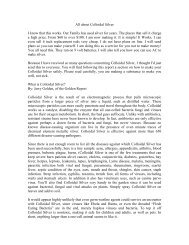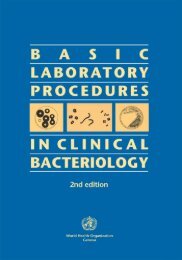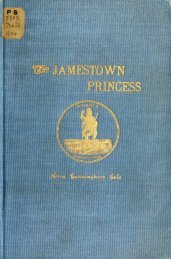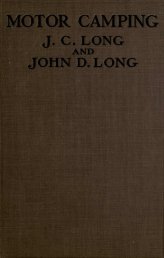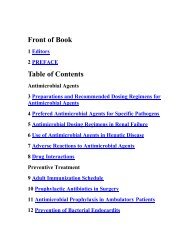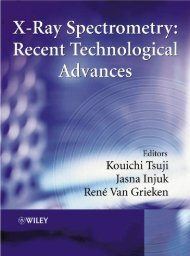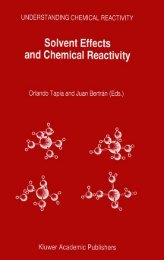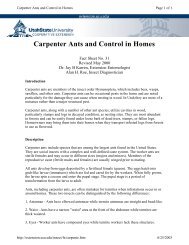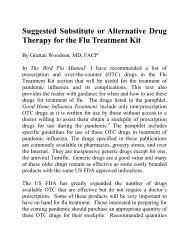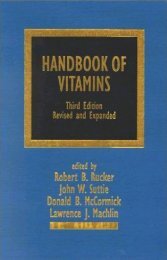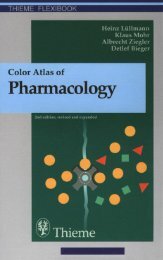The Nutritional Biochemistry of Chromium(III) - Survival-training.info
The Nutritional Biochemistry of Chromium(III) - Survival-training.info
The Nutritional Biochemistry of Chromium(III) - Survival-training.info
You also want an ePaper? Increase the reach of your titles
YUMPU automatically turns print PDFs into web optimized ePapers that Google loves.
Introduction: A history <strong>of</strong> chromium studies (1955–1995) 3removal <strong>of</strong> intravenously injected glucose to the approximately 4% rate <strong>of</strong> control rats.Brewer’s yeast and acid-hydrolyzed porcine kidney powder were identified as naturalsources <strong>of</strong> “GTF”, and the active (i.e., effective in reversing the inability to handle theglucose load) ingredient could be concentrated from these materials by physical andchemical means [4]. When given by stomach tube (500–1000 g/kg body mass), theintact materials and the concentrates could restore proper glucose metabolism in rats onthe Torula yeast-based diet. Although the separation means to isolate “GTF” were notdescribed in detail, “GTF” was found to be water-soluble, extractable with phenol andisobutanol, and absorbable on charcoal and ion-exchange resins.From the benefit <strong>of</strong> over 40 years <strong>of</strong> hindsight, these studies are deeplyflawed despite the success <strong>of</strong> similar studies in identifying other dietary requirements.Unfortunately, for example, the Cr content <strong>of</strong> the diet was not reported (although theexperimental procedures at the time would not have likely produced the correct value).Additionally, the rats were maintained in wire-mess cages, possibly with stainless steelcomponents, allowing the rats to obtain chromium by chewing on these components.Consequently, the actual Cr intake <strong>of</strong> the rats in these studies is impossible to gauge,putting into great question the suggestion that the rats were Cr deficient. <strong>The</strong> use <strong>of</strong> thelarge amounts <strong>of</strong> the metal ions is also <strong>of</strong> concern; as will be discussed in Chapter 9,large doses <strong>of</strong> chromium may have pharmacological effects, which may or may not berelated to any nutritional requirements. <strong>The</strong>se doses are probably about 10 3 times thetypical daily content <strong>of</strong> a rat’s diet. Questions about data handling and the significance<strong>of</strong> the effect observed from the chromium treatment have also been raised (vide infra).Considerable confusion in terminology in terms <strong>of</strong> the use <strong>of</strong> GTF has arisen.Studies over the last nearly 50 years have more <strong>of</strong>ten than not failed to distinguish thedifference among the inorganic ion Cr 3+ , Cr(<strong>III</strong>) complexes, and the biologically activeform <strong>of</strong> chromium (i.e., the naturally occurring biomolecule(s) which has an inherentfunction when containing bound Cr(<strong>III</strong>) if such exists), each called GTF. As originallyproposed in 1957, GTF is a substance that is involved in maintaining normal glucose,prevents and cures impairment <strong>of</strong> glucose removal when given in the diet or by stomachtube, and results in impairment <strong>of</strong> intravenous glucose tolerance when it is deficient inthe diet [3]. If one assumes that chromium is related to GTF and follows this definition,then GTF can only be the chromic ion, Cr 3+ . In publications soon after 1959, Mertzand Schwarz equated GTF and trivalent chromium [5, 6]. However, thereafter “GTF”takes on a different usage. As chromium must presumably interact with some organicbiomolecule(s) to manifest an effect(s) in mammals, attempts were subsequently madeto identify this (these) species. Unfortunately, the products <strong>of</strong> such attempts have alsobeen termed as “GTF”. To distinguish between organic Cr(<strong>III</strong>) complexes termed “GTF”and Cr 3+ being referred to as GTF, “GTF” when used to indicate an organic Cr(<strong>III</strong>)ligand complex will be enclosed in quotation marks.Research just prior to and in the 1960s was consistent with these early results.Continuing studies using rats fed a variety <strong>of</strong> diets found that rats on some dietsin addition to the Torula yeast-based diet apparently possessed low glucose removalrates; the glucose removal rates could be improved by addition <strong>of</strong> “GTF” concentrates.<strong>The</strong> concentrates were prepared from dried Brewer’s yeast, an enzymatic digest <strong>of</strong>Brewer’s yeast, and dried defatted porcine kidney powder [7]. However, the methods <strong>of</strong>preparation <strong>of</strong> these materials were not described; while the amounts <strong>of</strong> the concentrates



